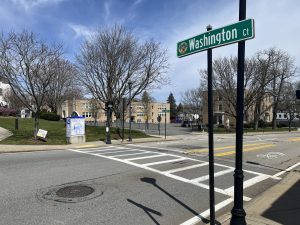Wellesley Select Board voices support for proposed Lower Falls zoning changes
The Wellesley Select Board this week heard from the Planning Board, Planning Department, and residents about two Special Town Meeting articles that could pave the way for more than 100 new multifamily housing units in Lower Falls.
Following deliberations, Select Board members voted to support both articles by 3-1 votes (member Tom Ulfelder was not present). The Board devoted close to two hours to the articles.

The articles, 16 and 17, involve proposed residential incentive overlays (RIOs) respectively at Washington Court and on Walnut Street that would allow for expanded development opportunities. A developer since spring has been discussing possible multifamily projects with neighbors and the town, and The Swellesley Report has posted articles and meeting agendas related to this issue at least a dozen times over that period.
The Planning Board recently voted to support both articles, as reported by The Swellesley Report, citing the town’s need for more housing and the location of these possible RIOs. The Advisory Committee, which vets articles and motions ahead of Annual and Special Town Meetings, voted a favorable recommendation for the Walnut Street-focused article (#17), but an unfavorable recommendation for the proposed Washington Court one, which involves a space abutting a residential neighborhood across from a church.
The Select Board on Tuesday (see Wellesley Media recording from the Oct. 8 meeting) heard from members of the public on both articles (the Board also received emails). Most of the speakers were neighbors of one or the other area that could have their zoning maps amended. They cited concerns about privacy, traffic, the environment, and the speed at which the process has moved.
Aaron Thomas, who lives near Washington Court and has shared feedback at other meetings on this matter, said “My biggest concern is the hasty approach and path that this project has been on. Why are we in such a rush to approve a RIO that could have permanent consequences?” He asked why the town isn’t taking a more holistic approach to Lower Falls development in light of many Haynes Management properties on the market.
While the articles are focused on the zoning map changes, the developer previewed multifamily housing plans to provide context for the proposals made in the articles. The developer has made changes to the plans based on town and resident feedback (most recently, reducing the planned number of condo units at Washington Court from 25 to 21, and moving the project further from neighbors).
During the Select Board’s deliberation, Chair Colette Aufranc said in thinking about the articles she stepped back to look at the broad goals of the town, including those outlined in its housing production plan, climate action plan, unified plan, and other plans. “These articles I think at their heart allow for multifamily housing to be developed… in both cases there are several aspects of the proposed amendment that I think aligns with the vision and goals of the town.” She cited the attractiveness of developing near commercial areas and the potential for 3-bedroom units that are in short supply.
In voicing support for the articles, Board member Marjorie Freiman referred to a Wellesley Housing Development Corp. study that pointed to the mismatch between housing supply and demand in town, including at different income levels, and the ongoing strategic housing plan effort. She also said: “The location satisfies not only the requirements, but the spirit and the aim of the expanded RIO provisions” as approved by Special Town Meeting in 2019.
Beth Sullivan Woods, who voted against supporting the articles, said it seemed to her that the proposals have come up “faster than normal.” With the town on the verge of complying with the MBTA Communities Act to support multifamily development near public transportation, already having reached the state threshold for having 10% of its housing stock deemed affordable, and approving projects that will bring hundreds of units to Rte. 9, Woods called for the town to pause and take a more holistic approach to housing. “This feels out of sync with the fact that we’re doing a [strategic housing plan] now,” she said. “It boggles my mind as a strategy person that we’re just putting puzzle pieces in before we decide what the puzzle is going to look like when we’re done.” On Walnut Street specifically, she urged caution about messing with that current medical corridor that houses various medical offices not far from the hospital.
Board member Lise Olney said she appreciated all of the public feedback for and against the articles, and for the Planning Board and Department answering questions. She cited the town’s DEI resolution (and commitment to be a more welcoming and inclusive community) and climate change resolution, both of which would apply to the town’s strategic support for multifamily housing. “The imaginative reuse of an underused property on a dead end” like Washington Court also appealed to Olney, who cited confidence in any subsequent permitting process.
Next up for the articles: Special Town Meeting, which starts on Oct. 21 at Wellesley High School.